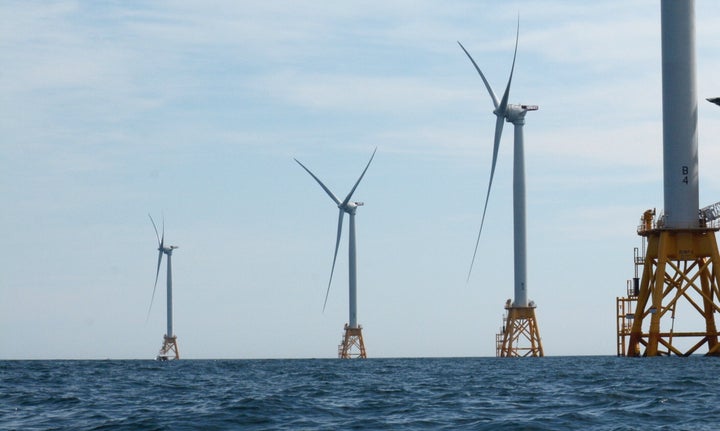The Biden administration is laying the policy groundwork to boost renewable energy production ahead of unveiling an anticipated $3 trillion package to prioritize green infrastructure and curb planet-altering greenhouse gas emissions.
On Friday, the Department of Energy set a new goal of slashing solar energy costs by 60% within the next decade and set aside $128 million to help speed up deployment of solar technologies. And at an event Monday, the administration announced a series of actions aimed at aggressively accelerating offshore wind development and creating tens of thousands of jobs.
The administration established a multi-agency target of deploying 30 gigawatts, or 30,000 megawatts, of wind energy by 2030, enough to power 10 million homes for a year and slash 78 million metric tons of carbon dioxide emissions.
There are currently only two small existing offshore wind farms in U.S. waters, one off the coast of Rhode Island and another off Virginia. Together they have a capacity of just 42 megawatts.
“I recognize that over the past few years, the federal government’s approach to offshore wind has probably seemed like a chicken with its head cut off,” Energy Secretary Jennifer Granholm said at Monday’s roundtable event. “But it is a new day under the Biden administration. This 30 gigawatt offshore wind goal demonstrates our commitment to what I call clean energy patriotism.”
The Biden administration on Monday also established a new priority wind area in New York Bight, the waters between Long Island and the New Jersey coast, and advanced permitting for the proposed 1,100-megawatt Ocean Wind project off the coast of southern New Jersey. And it announced up to $3 billion in loan opportunities for the offshore wind industry, $230 million in available funds to update port infrastructure to support offshore wind development, as well new investments in wind research and development projects.

The effort comes just weeks after the Interior Department gave Vineyard Wind, the long-stalled 800-megawatt project off the Cape Cod coast, the green light to move ahead. Once complete, the turbine array will be by far the nation’s largest offshore wind farm.
“For generations, we’ve put off the transition to clean energy, and now we face a climate crisis,” Interior Secretary Deb Haaland said at the event. “It’s a crisis that doesn’t discriminate.”
Meanwhile, the Interior Department is pressing ahead with a major review of the federal oil and gas leasing program. At a forum Friday with representatives of environmental justice, conservation, Indigenous, industry trade and labor groups, Interior Secretary Deb Haaland defended the administration’s temporary pause on new oil and gas leases on federal lands and water.
“During the past four years, the Trump Administration offered vast swaths of our public lands and waters for drilling, prioritizing fossil fuel development above all other uses on public lands and waters,” she said. “While some corporations profited, taxpayers were shortchanged, and some Americans’ voices were not heard.”
President Joe Biden ran on an ambitious agenda to not only restore the climate regulations the Trump administration gutted but set the world’s No. 2 emitter on course for net-zero climate pollution by the middle of the century. The first major thrust toward realizing that vision is expected to come this week when the White House announces its plan to spend trillions rebuilding the country’s roads, ports, and bridges and steeling infrastructure for an increasingly hot and chaotic climate reality.
The proposal is expected to include roughly $400 billion for investments in climate-friendly infrastructure such as green public transit and renewables, according to The Washington Post.
But Biden faces mounting pressure from members of his own party to go even bigger with a $10 trillion, decadelong plan that progressives say would dwarf the White House’s vision.
Aggressive efforts to deploy renewables are key to restoring U.S. credibility ahead of the next round of United Nations climate negotiations. China, the world’s top emitter, intensified its decarbonization plan this month with explicit new mandates for its vast government bureaucracy to slash pollution and transition to renewable. Since the pandemic, the European Union has taken some of the clearest steps to integrate renewables and electric vehicles into its recovery plans, while the United Kingdom, which recently exited the bloc, is investing heavily in green industry.
“President Biden believes we have an enormous opportunity in front of us to not only address the threats of climate change, but use it as a chance to create millions of good-paying, union jobs that will fuel America’s economic recovery, rebuild the middle class, and make sure we bounce back from the crises we face,” Gina McCarthy, Biden’s domestic climate czar, said in a statement accompanying Monday’s announcement. “Nowhere is the scale of that opportunity clearer than for offshore wind.”